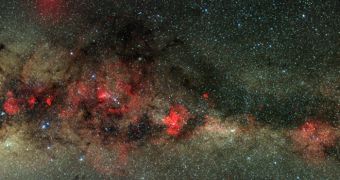According to astronomers, our solar system is traveling through space inside a structure known as the Local Bubble. In fact, this is but one in many cavity-like structure that appear to exist in the interstellar medium at our location in the Milky Way.
The interstellar medium (ISM) is a term experts use to refer to a variety of process, phenomena and types of matter that exist in the space between two neighboring stars. The ISM predominately contains gas (in ionic, atomic and molecular forms) and cosmic rays.
This medium also represents a smooth transition boundary between the interior and exterior of a galaxy. The latter is marked by the intergalactic space, which features about the same components as ISM does, plus a few more.
Scientists now believe that the solar system is circulating through the Milky Way inside a bubble that was produced in the ISM by past, powerful stellar explosions, such as for example supernova events.
The structure is called the Local Bubble, and it is actually an areas of low-density ISM. Its names does not imply that there is nothing except our solar system within. All the radiation and matter usually associated with the interstellar medium are there alright, except in diminished concentrations.
Experts are currently in the process of determining the influence that this had on the development of life on Earth. It could be for example that our solar system was protected from a host of dangerous cosmic events that may have otherwise destroyed the earliest lifeforms.
It is also important to note here that Earth and the Sun were both born directly inside this Local Bubble, which apparently was formed long before a molecular hydrogen gas clod in the ISM collapsed to form our star and everything around it.
Generally, the interstellar medium is a very dynamic environment. It promotes the formation of new stars in stellar nurseries, and is the main measure that dictates for how long a galaxy will be able to grow and produce new celestial fireballs.
At the same time, the material that is taken away from the ISM when new stars are born is put back when the objects die. Resulting supernovae and planetary nebulae stir the medium again, setting the stage for the formation of new stars.
Brutal solar winds produced by young, blue stars also contribute to this, experts say, quoted by Daily Galaxy.

 14 DAY TRIAL //
14 DAY TRIAL //